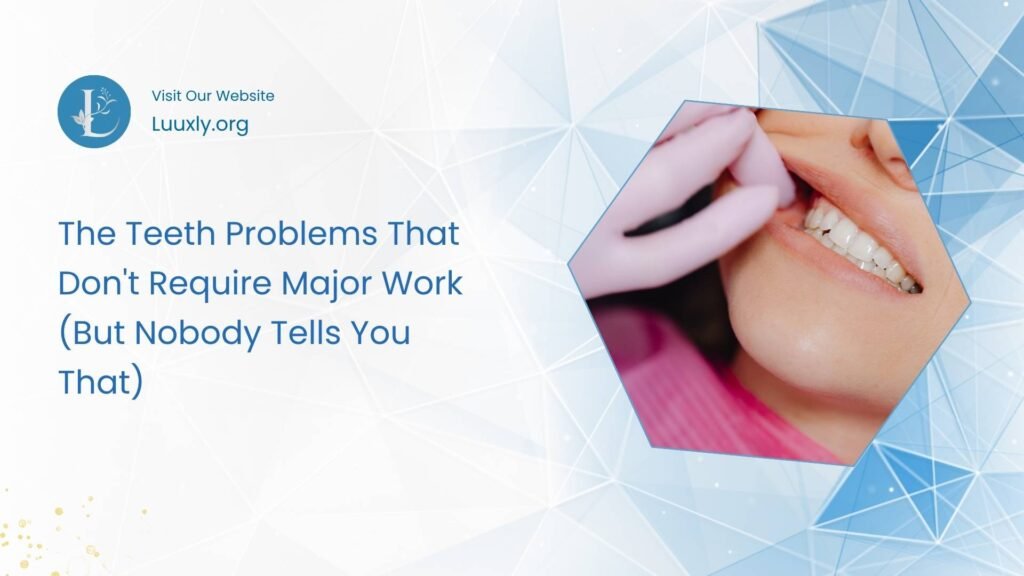
There’s a common assumption that fixing teeth always means drilling, crowns, or months of orthodontic treatment. Dental work has this reputation for being invasive, expensive, and time-consuming. While that’s true for some issues, a surprising number of dental problems can be fixed with much simpler approaches.
The gap between what people think they need and what they actually need is often pretty wide. Someone might avoid dealing with a chipped tooth for years, assuming the fix will be complicated and costly, when the reality is far less daunting. Understanding which problems fall into this category can change how people approach their dental concerns entirely.
Small Chips and Minor Fractures
Chipped teeth are one of those things that look worse than they are, at least from a treatment perspective. A small chip on a front tooth might feel like a major flaw, but it’s often one of the easier dental issues to address. The tooth structure is still intact, the nerve isn’t exposed, and the damage is purely on the surface.
For chips that don’t go too deep, tooth-colored resin can be applied directly to the damaged area without any drilling or major preparation. The dentist roughens the surface slightly, applies the material, shapes it to match the rest of the tooth, and hardens it with a light. The whole process usually takes less than an hour per tooth.
The best part is that this approach preserves the natural tooth structure. There’s no need to grind down the tooth or remove healthy enamel. The fix is reversible too, meaning if the repair ever needs to be redone or changed, the original tooth underneath remains untouched. For minor chips, this is often all that’s needed.
Gaps Between Teeth
Small gaps between teeth, particularly the front ones, can bother people for years. The automatic assumption is that closing these gaps means braces or clear aligners, months or years of treatment, and significant cost. But for gaps that are relatively small (a few millimeters), there’s often a much faster option.
Adding composite material to the sides of teeth can effectively close small gaps in a single appointment. The best composite bonding for teeth can reshape the edges of teeth adjacent to the gap, making them slightly wider so they meet in the middle. This works particularly well for gaps between the two front teeth.
The limitation here is gap size. For larger spaces or gaps throughout the mouth, orthodontic treatment might still be the better choice. But for that one annoying gap that’s been bothering someone since childhood, bonding can solve it in an afternoon without moving any teeth at all.
Slightly Uneven Tooth Lengths
Teeth that are subtly different lengths can throw off the appearance of a smile without being obviously wrong. Maybe one front tooth is a millimeter shorter than its neighbor, or the teeth on one side don’t quite line up with the other side. These small irregularities are more common than people realize.
Building up short teeth with composite material can even out these differences without touching the longer teeth. The dentist essentially extends the shorter tooth to match the others, creating a more balanced smile line. This is far less involved than grinding down the longer teeth (which would require crowns or veneers) or using orthodontics to adjust tooth position.
The process is straightforward and doesn’t require removing any tooth structure. The material bonds to the existing tooth, extending its length where needed. If someone isn’t happy with the result, it can be adjusted or removed without any permanent changes to the natural teeth.
Surface Stains and Discoloration
Not all tooth discoloration requires aggressive whitening treatments or veneers. Surface stains from coffee, tea, or tobacco often respond well to professional cleaning and polishing. What looks like deep staining is sometimes just buildup on the tooth surface that comes off with proper cleaning.
For stains that go a bit deeper but aren’t truly intrinsic, professional whitening can make a significant difference without any permanent changes to tooth structure. The bleaching agents penetrate the enamel to break down stain molecules, and the process is completely reversible. If someone doesn’t like the results or wants to go back to their natural shade, they simply stop whitening and the color gradually returns.
Even some intrinsic stains (stains within the tooth structure) can be masked with thin applications of composite without the need for full veneers. This approach works for small areas of discoloration or single teeth that don’t match the others. It’s not appropriate for all cases, but for localized issues, it’s far less invasive than other options.
Minor Tooth Wear
Teeth naturally wear down over time, but sometimes the wear happens faster or more noticeably in certain areas. The edges of front teeth can become thin and slightly translucent, or the biting surfaces of back teeth might flatten out. This wear often makes teeth look older and can sometimes cause sensitivity.
Adding material to worn areas can restore the tooth’s shape and protect it from further damage. For front teeth, composite can be applied to the edges to rebuild what’s been lost. For back teeth, the biting surfaces can be built up to restore function and reduce sensitivity.
This is preventive in a way, because addressing minor wear early can prevent more serious problems down the road. Once significant tooth structure is lost, the solutions become more complex and expensive. Catching it early means simpler fixes.
Slightly Misshapen Teeth
Some teeth just grow in odd shapes. Maybe a lateral incisor (the tooth next to the front tooth) is narrower and more pointed than it should be, or a canine is bulkier than its partner on the other side. These shape irregularities aren’t functional problems, but they can affect how a smile looks.
Reshaping with composite material can adjust these proportions without orthodontics or major restorations. A narrow tooth can be widened, a pointed tooth can be rounded, or an oversized tooth can be contoured to better match its neighbors. The changes are subtle but make a real difference in overall appearance.
The key here is that the natural tooth provides the foundation. The dentist is just refining the shape, not replacing it entirely. This preserves tooth structure while achieving a more balanced result.
White Spots on Teeth
White spots on tooth enamel can come from various causes, including early decay, fluorosis, or demineralization. These spots often stand out more than darker stains because they contrast with the surrounding tooth color. People sometimes assume these need extensive treatment.
For many white spots, a technique called resin infiltration can minimize their appearance without drilling. This involves preparing the enamel surface and allowing a liquid resin to penetrate the porous areas, filling in the white spots and making them blend better with the rest of the tooth. The process doesn’t remove tooth structure and takes about an hour.
For spots that don’t respond to infiltration, a thin layer of composite can be placed over them. This is still far less involved than veneers and preserves most of the natural tooth.
Understanding Treatment Options
The pattern across all these issues is that they’re surface level or minor enough that they don’t require removing significant tooth structure or extensive dental work. They’re problems that bother people visually or cause mild discomfort, but they haven’t progressed to the point where major intervention is necessary.
Knowing this distinction matters because it affects how people approach dental treatment. Someone who thinks they need thousands of pounds worth of veneers might actually need a few hundred pounds worth of bonding. Someone avoiding the dentist because they assume the fix will be painful and invasive might find out the solution is quick and comfortable.
The important thing is getting an accurate assessment of what the problem actually is and what the simplest effective solution would be. Not every dental issue requires the most extensive treatment option, and in many cases, the minimally invasive approach works just as well while preserving more of the natural tooth.



